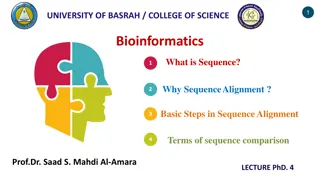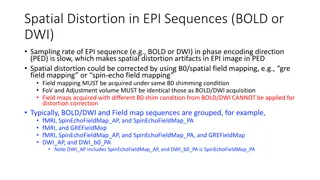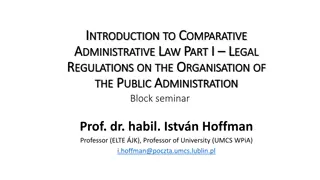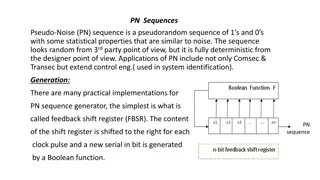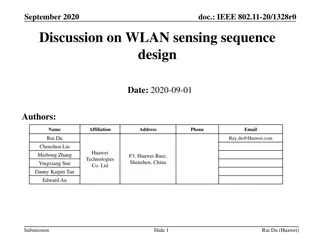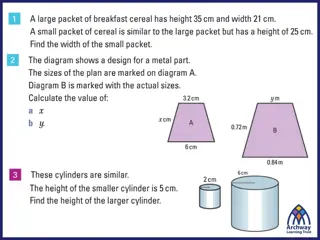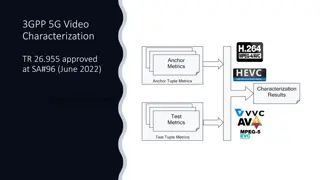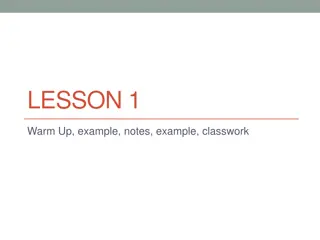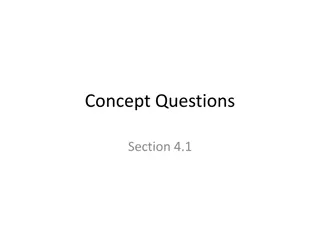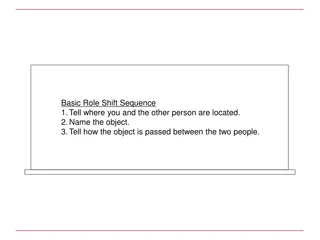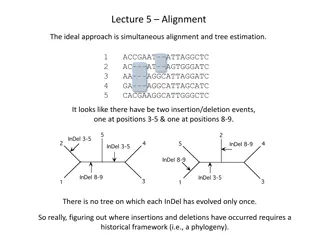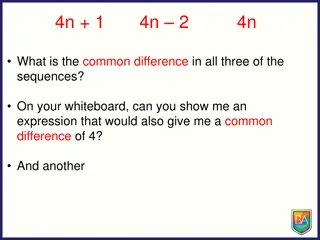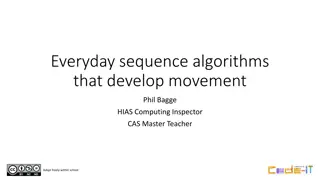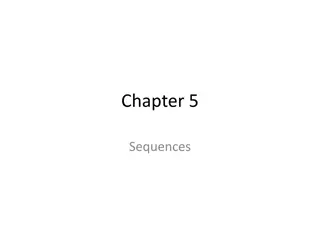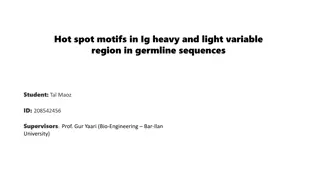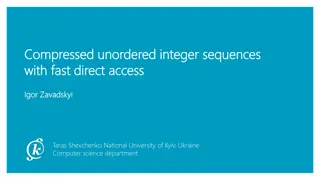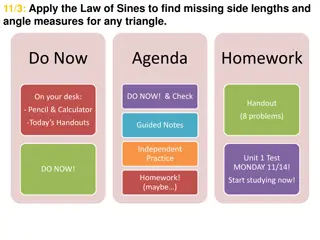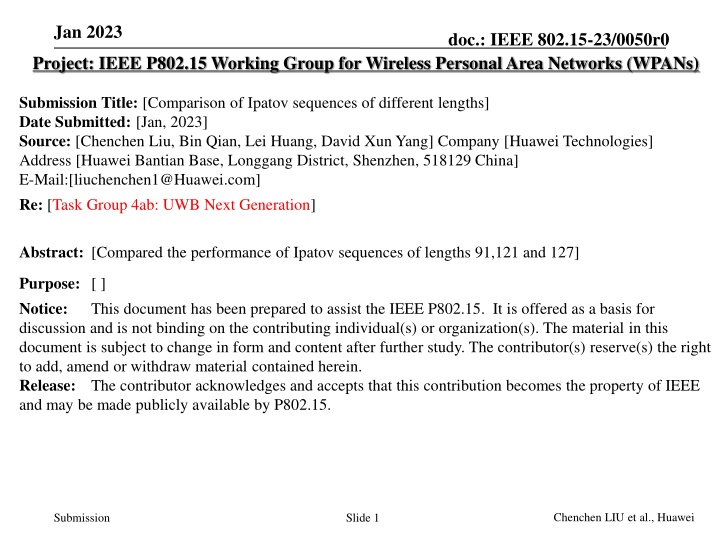
Performance Analysis of Ipatov Sequences in UWB Next Generation
Explore the performance of different lengths of Ipatov sequences (91, 121, and 127) for synchronization and sensing in UWB applications. The study compares their cardinality, cross-correlations, and the probabilities of interference in uncoordinated UWB devices. This research sheds light on the selection criteria for optimal Ipatov sequences in wireless personal area networks.
Download Presentation

Please find below an Image/Link to download the presentation.
The content on the website is provided AS IS for your information and personal use only. It may not be sold, licensed, or shared on other websites without obtaining consent from the author. If you encounter any issues during the download, it is possible that the publisher has removed the file from their server.
You are allowed to download the files provided on this website for personal or commercial use, subject to the condition that they are used lawfully. All files are the property of their respective owners.
The content on the website is provided AS IS for your information and personal use only. It may not be sold, licensed, or shared on other websites without obtaining consent from the author.
E N D
Presentation Transcript
Jan 2023 doc.: IEEE 802.15-23/0050r0 Project: IEEE P802.15 Working Group for Wireless Personal Area Networks (WPANs) Submission Title: [Comparison of Ipatov sequences of different lengths] Date Submitted: [Jan, 2023] Source: [Chenchen Liu, Bin Qian, Lei Huang, David Xun Yang] Company [Huawei Technologies] Address [Huawei Bantian Base, Longgang District, Shenzhen, 518129 China] E-Mail:[liuchenchen1@Huawei.com] Re: [Task Group 4ab: UWB Next Generation] Abstract: [Compared the performance of Ipatov sequences of lengths 91,121 and 127] Purpose: [ ] Notice: discussion and is not binding on the contributing individual(s) or organization(s). The material in this document is subject to change in form and content after further study. The contributor(s) reserve(s) the right to add, amend or withdraw material contained herein. Release: The contributor acknowledges and accepts that this contribution becomes the property of IEEE and may be made publicly available by P802.15. This document has been prepared to assist the IEEE P802.15. It is offered as a basis for Chenchen LIU et al., Huawei Submission Slide 1
Jan 2023 doc.: IEEE 802.15-23/0050r0 Related Submissions 15-21-0377-00-04ab-preamble-codes-for-data- communications (Carlos Aldana) 15-22-0507-00-04ab-simulation-evaluation-of- preamble-sequences-for-4ab (Chenchen Liu) Chenchen LIU et al., Huawei Submission Slide 2
Jan 2023 doc.: IEEE 802.15-23/0050r0 Background Ipatov sequence can be a good candidate for both synchronization and sensing There are serval different candidate lengths, such as 91, 121and 127 The performance of different Ipatov sequence will be analyzed in this contribution Chenchen LIU et al., Huawei Submission Slide 3
Jan 2023 doc.: IEEE 802.15-23/0050r0 Cardinality of Ipatov Sequence The cardinality of Ipatov sequences that can not be transformed into each other by cyclic shifts or multiplication by a constant (half of them are the reverse of the other half) is shown below[1] A subset of sequences can be selected to have low cross correlations with each other[2] Len=91 Len=121 Len=127 Cardinality 24 22 ? Cardinality(with low cross correlation) 8 22 16 With increasing number of UWB devices, the cardinality of the selected Ipatov sequences is expected to be large in order to reduce the interference Chenchen LIU et al., Huawei Submission Slide 4
Jan 2023 doc.: IEEE 802.15-23/0050r0 Cardinality of Ipatov Sequence The Probability that two uncoordinated UWB devices choose the same sequence for different cardinality Chenchen LIU et al., Huawei Submission Slide 5
Jan 2023 doc.: IEEE 802.15-23/0050r0 PRF Problem The number of non-zero elements and its PRF with SF=1 is shown in the table below Len=91 Len=121 Len=127 No. of non-zeros 81 81 64 PRF (SF=1) 0.89*BW 0.67*BW 0.5*BW The final mean PRF can be adjusted by changing the SF. The transmit energy is determined by the mean PRF and number of symbol repetitions The limit on SF is the channel PDP (CM6 and CM8:900ns, Others: < 330ns[3]) and sequence length. By setting the SF and number of repetitions, sequence of different length can have similar mean PRF and energy (e.g., length 91 with SF=4 have the same mean PRF as length 121 with SF=3) Chenchen LIU et al., Huawei Submission Slide 6
Jan 2023 doc.: IEEE 802.15-23/0050r0 Auto-correlation Ipatov sequences are selected for use because of their perfect periodic autocorrelation properties, which can improved sensing and channel estimation performance. With CFO, the auto-correlation performance may degrade. The detailed results will be shown with SF=4 and center frequency being 8GHz The normalized Peak-to-Sidelobe Level (PSL) metric is used ???(?,?) ???(0,?), where ? 1 PSL= max ? ? ?(? + ?)?? ?2?? ?? ???(?,?) = ? 0, ?=0 ? [0,???] Chenchen LIU et al., Huawei Submission Slide 7
Jan 2023 doc.: IEEE 802.15-23/0050r0 Auto-correlation The PSL for CFO=0.1ppm and 40ppm Seq25 Seq26 Seq27 Seq28 Seq29 Seq30 Seq31 Seq32 PSR(dB) Len=91 CFO=0.1 - -72.5 72.5 - -72.8 72.8 - -72.1 72.1 - -73.5 73.5 - -72.2 72.2 - -72.8 72.8 - -72.4 72.4 - -72.9 72.9 CFO=40 - -20.2 20.2 - -20.3 20.3 - -19.7 19.7 - -21.1 21.1 - -20.1 20.1 - -20.5 20.5 - -19.9 19.9 - -20.7 20.7 PSR(dB) Len=127 Seq9 Seq10 Seq11 Seq12 Seq13 Seq14 Seq15 Seq16 Seq17 Seq18 Seq19 Seq20 Seq21 Seq22 Seq23 Seq24 CFO=0.1 - -69.7 69.7 - -69.5 69.5 - -68.6 68.6 - -67 67 - -69.1 69.1 - -69.4 69.4 - -70.7 70.7 - -69.5 69.5 - -69.7 69.7 - -69.5 69.5 - -68.6 68.6 - -67 67 - -69.1 69.1 - -69.4 69.4 - -70.7 70.7 - -69.5 69.5 CFO=40 - -17 17 - -17.2 17.2 - -16.3 16.3 - -14.4 14.4 - -16.3 16.3 - -17 17 - -17.8 17.8 - -17 17 - -17 17 - -17.2 17.2 - -16.3 16.3 - -14.4 14.4 - -16.3 16.3 - -17 17 - -17.8 17.8 - -17 17 PSR(dB) Len=121 s1 s2 s3 s4 s5 s6 s7 s8 s9 s10 s11 s12 s13 s14 s15 s16 s17 s18 s19 s20 s21 s22 - -69.6 69.6- -70.2 70.2- -69.6 69.6- -70.2 70.2- -71.2 71.2- -71.2 71.2- -69.2 69.2- -69.2 69.2- -69.5 69.5- -69.5 69.5- -68.1 68.1- -68.1 68.1- -69.8 69.8- -69.8 69.8- -70.2 70.2- -69.2 69.2- -69.2 69.2- -70.2 70.2- -70.3 70.3- -70.2 70.2- -70.3 70.3- -70.2 70.2 CFO=0.1 - -17 17 - -17.5 17.5 - -17 17 - -17.5 17.5- -18.6 18.6- -18.6 18.6- -16.6 16.6- -16.6 16.6- -16.9 16.9- -16.9 16.9- -15.7 15.7- -15.7 15.7- -17.4 17.4- -17.4 17.4- -17.7 17.7- -16.9 16.9- -16.9 16.9- -17.7 17.7- -17.6 17.6- -17.7 17.7- -17.6 17.6- -17.7 17.7 CFO=40 Chenchen LIU et al., Huawei Submission Slide 8
Jan 2023 doc.: IEEE 802.15-23/0050r0 Cross-correlation Low cross-correlation can reduce the interference and help the coexistence with legacy UWB devices The cross-correlation is evaluated with the normalized cross-correlation peak (NCP): ( ) max (0) CC x,x CC 1 N , where x,y = NCP ( ) = + ( ) ( x n y n ) CC x,y , x y N = 0 n In general, the CFO will lower the cross-correlation peak, so the cross-correlation with CFO=0 can be regarded as the worst case, especially when accumulated through multiple symbols Chenchen LIU et al., Huawei Submission Slide 9
Jan 2023 doc.: IEEE 802.15-23/0050r0 Cross-correlation NCP for Ipatov sequence of length 91 NCP(? ?,? ?) (dB) Seq25 Seq26 Seq27 Seq28 Seq29 Seq30 Seq31 Seq32 Seq25 0 -14.6 -10.2 -10.6 -10.6 -13.6 -9.5 -13.1 Seq26 -14.6 0 -10.6 -13.6 -10.2 -10.6 -10.6 -10.9 Seq27 -10.2 -10.6 0 -14.6 -13.6 -10.6 -10.2 -10.6 Seq28 -10.6 -13.6 -14.6 0 -10.6 -10.2 -12.1 -9.5 Seq29 -10.6 -10.2 -13.6 -10.6 0 -14.6 -13.1 -12.1 Seq30 -13.6 -10.6 -10.6 -10.2 -14.6 0 -10.9 -10.2 Seq31 -9.5 -10.6 -10.2 -12.1 -13.1 -10.9 0 -10.6 Seq32 -13.1 -10.9 -10.6 -9.5 -12.1 -10.2 -10.6 0 Chenchen LIU et al., Huawei Submission Slide 10
Jan 2023 doc.: IEEE 802.15-23/0050r0 Cross-correlation NCP for Ipatov sequence of length 127 NCP(? ?,? ?) (dB) Seq9 Seq10 Seq11 Seq12 Seq13 Seq14 Seq15 Seq16 Seq17 Seq18 Seq19 Seq20 Seq21 Seq22 Seq23 Seq24 0 -18.1 0 -18.1 -18.1 -14.5 -14.5 -14.5 -14.5 -10.1 -13.2 -10.1 -9.3 -10.1 -12 -14.5 -10.1 -18.1 -18.1 0 -18.1 -14.5 -14.5 -18.1 -14.5 -14.5 -10.1 -13.2 -16.1 -10.1 -18.1 -14.5 -10.1 -18.1 -18.1 -18.1 0 -14.5 -14.5 -14.5 -14.5 -10.1 -9.3 -16.1 -16.1 -18.1 -10.1 -9.3 -12 -14.5 -14.5 -14.5 -14.5 0 -14.5 -18.1 -18.1 -14.5 -10.1 -10.1 -18.1 -13.2 -14.5 -9.3 -10.1 -14.5 -14.5 -14.5 -14.5 -14.5 0 -14.5 -18.1 -14.5 -12 -18.1 -10.1 -14.5 -16.1 -14.5 -16.1 -14.5 -14.5 -18.1 -14.5 -18.1 -14.5 0 -13.2 -10.1 -14.5 -14.5 -9.3 -9.3 -14.5 -7.5 -18.1 -12 -14.5 -14.5 -14.5 -18.1 -18.1 -13.2 0 -18.1 -10.1 -10.1 -12 -10.1 -16.1 -18.1 -13.2 -7.5 -10.1 -14.5 -10.1 -14.5 -14.5 -10.1 -18.1 0 -18.1 -18.1 -18.1 -14.5 -14.5 -14.5 -12 -10.1 -13.2 -10.1 -9.3 -10.1 -12 -14.5 -10.1 -18.1 0 -18.1 -18.1 -14.5 -14.5 -14.5 -14.5 -14.5 -10.1 -13.2 -16.1 -10.1 -18.1 -14.5 -10.1 -18.1 -18.1 0 -18.1 -14.5 -14.5 -18.1 -14.5 -10.1 -9.3 -16.1 -16.1 -18.1 -10.1 -9.3 -12 -18.1 -18.1 -18.1 0 -14.5 -14.5 -14.5 -14.5 -14.5 -10.1 -10.1 -18.1 -13.2 -14.5 -9.3 -10.1 -14.5 -14.5 -14.5 -14.5 0 -14.5 -18.1 -18.1 -14.5 -12 -18.1 -10.1 -14.5 -16.1 -14.5 -16.1 -14.5 -14.5 -14.5 -14.5 -14.5 0 -14.5 -18.1 -10.1 -14.5 -14.5 -9.3 -9.3 -14.5 -7.5 -18.1 -14.5 -14.5 -18.1 -14.5 -18.1 -14.5 0 -13.2 -18.1 -10.1 -10.1 -12 -10.1 -16.1 -18.1 -13.2 -12 -14.5 -14.5 -14.5 -18.1 -18.1 -13.2 0 Seq9 -18.1 -18.1 -18.1 -14.5 -14.5 -14.5 -12 -7.5 -10.1 -14.5 -10.1 -14.5 -14.5 -10.1 -18.1 Seq10 Seq11 Seq12 Seq13 Seq14 Seq15 Seq16 Seq17 Seq18 Seq19 Seq20 Seq21 Seq22 Seq23 Seq24 Chenchen LIU et al., Huawei Submission Slide 11
Jan 2023 doc.: IEEE 802.15-23/0050r0 Cross-correlation NCP for Ipatov sequence of length 121 0 -19.1 -14.6 -19.1 -13.1 -13.1 -14.6 -19.1 -11.7 -11.7 -13.1 -13.1 -11.7 -13.1 -13.1 -19.1 -19.1 -11.7 -19.1 -11.7 -14.6 -11.7 (dB) s1 s2 s3 s4 s5 s6 s7 s8 s9 s10 s11 s12 s13 s14 s15 s16 s17 s18 s19 s20 s21 s22 s1 -19.1 0 -19.1 -14.6 -13.1 -13.1 -11.7 -11.7 -19.1 -19.1 -11.7 -13.1 -14.6 -19.1 -13.1 -11.7 -11.7 -13.1 -13.1 -19.1 -11.7 -14.6 s2 -14.6 -19.1 0 -19.1 -13.1 -13.1 -19.1 -14.6 -11.7 -11.7 -13.1 -13.1 -13.1 -11.7 -11.7 -19.1 -19.1 -13.1 -14.6 -11.7 -19.1 -11.7 s3 -19.1 -14.6 -19.1 0 -13.1 -13.1 -11.7 -11.7 -19.1 -19.1 -13.1 -11.7 -19.1 -14.6 -13.1 -11.7 -11.7 -13.1 -11.7 -14.6 -13.1 -19.1 s4 -13.1 -13.1 -13.1 -13.1 0 -14.6 -19.1 -14.6 -13.1 -11.7 -19.1 -19.1 -11.7 -11.7 -19.1 -11.7 -13.1 -19.1 -11.7 -19.1 -11.7 -14.6 s5 -13.1 -13.1 -13.1 -13.1 -14.6 0 -14.6 -19.1 -11.7 -13.1 -19.1 -19.1 -11.7 -11.7 -19.1 -13.1 -11.7 -19.1 -11.7 -14.6 -11.7 -19.1 s6 -14.6 -11.7 -19.1 -11.7 -19.1 -14.6 0 -14.6 -19.1 -19.1 -11.7 -11.7 -19.1 -19.1 -11.7 -11.7 -13.1 -13.1 -13.1 -13.1 -13.1 -13.1 s7 -19.1 -11.7 -14.6 -11.7 -14.6 -19.1 -14.6 0 -19.1 -19.1 -11.7 -11.7 -19.1 -19.1 -13.1 -13.1 -11.7 -11.7 -13.1 -13.1 -13.1 -13.1 s8 -11.7 -19.1 -11.7 -19.1 -13.1 -11.7 -19.1 -19.1 0 -14.6 -14.6 -19.1 -11.7 -11.7 -13.1 -14.6 -19.1 -13.1 -13.1 -13.1 -13.1 -11.7 s9 -11.7 -19.1 -11.7 -19.1 -11.7 -13.1 -19.1 -19.1 -14.6 0 -19.1 -14.6 -11.7 -11.7 -13.1 -19.1 -14.6 -13.1 -13.1 -11.7 -13.1 -13.1 s10 -13.1 -11.7 -13.1 -13.1 -19.1 -19.1 -11.7 -11.7 -14.6 -19.1 0 -14.6 -19.1 -19.1 -11.7 -13.1 -13.1 -11.7 -14.6 -11.7 -19.1 -13.1 s11 -13.1 -13.1 -13.1 -11.7 -19.1 -19.1 -11.7 -11.7 -19.1 -14.6 -14.6 0 -19.1 -19.1 -11.7 -13.1 -13.1 -11.7 -19.1 -13.1 -14.6 -11.7 s12 -11.7 -14.6 -13.1 -19.1 -11.7 -11.7 -19.1 -19.1 -11.7 -11.7 -19.1 -19.1 0 -14.6 -14.6 -13.1 -13.1 -19.1 -11.7 -13.1 -13.1 -13.1 s13 -13.1 -19.1 -11.7 -14.6 -11.7 -11.7 -19.1 -19.1 -11.7 -11.7 -19.1 -19.1 -14.6 0 -19.1 -13.1 -13.1 -14.6 -13.1 -13.1 -11.7 -13.1 s14 -13.1 -13.1 -11.7 -13.1 -19.1 -19.1 -11.7 -13.1 -13.1 -13.1 -11.7 -11.7 -14.6 -19.1 0 -19.1 -14.6 -14.6 -19.1 -11.7 -19.1 -11.7 s15 -19.1 -11.7 -19.1 -11.7 -11.7 -13.1 -11.7 -13.1 -14.6 -19.1 -13.1 -13.1 -13.1 -13.1 -19.1 0 -14.6 -14.6 -11.7 -19.1 -11.7 -19.1 s16 -19.1 -11.7 -19.1 -11.7 -13.1 -11.7 -13.1 -11.7 -19.1 -14.6 -13.1 -13.1 -13.1 -13.1 -14.6 -14.6 0 -19.1 -11.7 -19.1 -11.7 -19.1 s17 -11.7 -13.1 -13.1 -13.1 -19.1 -19.1 -13.1 -11.7 -13.1 -13.1 -11.7 -11.7 -19.1 -14.6 -14.6 -14.6 -19.1 0 -19.1 -11.7 -19.1 -11.7 s18 -19.1 -13.1 -14.6 -11.7 -11.7 -11.7 -13.1 -13.1 -13.1 -13.1 -14.6 -19.1 -11.7 -13.1 -19.1 -11.7 -11.7 -19.1 0 -19.1 -14.6 -19.1 s19 -11.7 -19.1 -11.7 -14.6 -19.1 -14.6 -13.1 -13.1 -13.1 -11.7 -11.7 -13.1 -13.1 -13.1 -11.7 -19.1 -19.1 -11.7 -19.1 0 -19.1 -14.6 s20 -14.6 -11.7 -19.1 -13.1 -11.7 -11.7 -13.1 -13.1 -13.1 -13.1 -19.1 -14.6 -13.1 -11.7 -19.1 -11.7 -11.7 -19.1 -14.6 -19.1 0 -19.1 s21 Chenchen LIU et al., Huawei Submission s22 Slide 12 -11.7 -14.6 -11.7 -19.1 -14.6 -19.1 -13.1 -13.1 -11.7 -13.1 -13.1 -11.7 -13.1 -13.1 -11.7 -19.1 -19.1 -11.7 -19.1 -14.6 -19.1 0
Jan 2023 doc.: IEEE 802.15-23/0050r0 Cross-correlation The PDF of NCP for Ipatov sequence of different lengths Chenchen LIU et al., Huawei Submission Slide 13
Jan 2023 doc.: IEEE 802.15-23/0050r0 Summary Consider the future increasing of UWB devices, the cardinality of the selected Ipatov sequences shall be large Different length Ipatov sequence can have similar mean PRF and energy by setting the SF and repetition properly All the Ipatov sequences have very good autocorrelation even if the CFO is as larger as 40ppm The Ipatov sequence of length 121 have good cross correlation between each other Chenchen LIU et al., Huawei Submission Slide 14
Jan 2023 doc.: IEEE 802.15-23/0050r0 References [1] V. P. Ipatov, Ternary sequences with ideal autocorrelation properties Radio Eng. Electron. Phys., vol. 24, pp. 75 79, Oct. 1979. [2] 15-18-0590-00-004z-hrp-uwb-phy-enhanced-mode-converged-consensus (Billy Verso) [3] 15-21-0377-00-04ab-preamble-codes-for-data-communications (Carlos Aldana) [4] 15-22-0616-00-04ab-interference-analysis-of-initial-synchronization-sequence.pptx (Chenchen Liu) [5] 15-22-0507-00-04ab-simulation-evaluation-of-preamble-sequences-for-4ab(Chenchen Liu) [6] D. Shedd and D. Sarwate, "Construction of sequences with good correlation properties (Corresp.)," in IEEE Transactions on Information Theory, vol. 25, no. 1, pp. 94-97, January 1979 [7] T. Hoholdt and J. Justesen, "Ternary sequences with perfect periodic autocorrelation (Corresp.)," in IEEE Transactions on Information Theory, vol. 29, no. 4, pp. 597-600, July 1983 [8] P802.15.4z, Draft Standard for Low-Rate Wireless Networks Chenchen LIU et al., Huawei Submission Slide 15
Jan 2023 doc.: IEEE 802.15-23/0050r0 Appendix Ipatov sequences of length 121 Sequence Code sequence 1 0 0 0 -1 1 0 0 -1 0 1 0 -1 -1 1 1 -1 1 0 -1 0 0 1 -1 -1 0 1 0 1 -1 1 1 1 0 0 -1 -1 1 0 -1 1 0 1 -1 0 1 1 0 -1 1 -1 1 -1 0 0 0 0 -1 0 0 0 -1 -1 0 0 -1 1 -1 0 -1 0 0 -1 -1 -1 0 -1 1 1 -1 -1 0 -1 0 1 -1 -1 -1 1 0 1 1 0 1 1 -1 1 1 -1 0 0 -1 0 -1 0 -1 -1 -1 -1 -1 1 1 1 1 0 -1 -1 -1 1 -1 1 s1 1 0 -1 0 -1 1 -1 1 -1 0 0 1 -1 1 1 1 1 0 -1 0 1 1 0 1 -1 -1 -1 0 0 0 0 -1 0 1 0 0 -1 -1 -1 1 -1 - 1 1 -1 1 1 0 1 1 -1 0 0 0 -1 -1 1 1 0 -1 1 1 0 0 1 0 0 0 -1 1 1 -1 0 -1 0 0 -1 1 0 -1 1 -1 0 -1 1 0 1 1 0 0 -1 0 -1 0 -1 -1 -1 0 -1 0 1 -1 0 0 -1 -1 0 1 1 -1 1 0 -1 -1 -1 -1 -1 1 1 -1 -1 -1 s2 1 -1 1 -1 -1 -1 0 1 1 1 1 -1 -1 -1 -1 -1 0 -1 0 -1 0 0 -1 1 1 -1 1 1 0 1 1 0 1 -1 -1 -1 1 0 -1 0 -1 - 1 1 1 -1 0 -1 -1 -1 0 0 -1 0 -1 1 -1 0 0 -1 -1 0 0 0 -1 0 0 0 0 -1 1 -1 1 -1 0 1 1 0 -1 1 0 1 -1 0 1 -1 -1 0 0 1 1 1 -1 1 0 1 0 -1 -1 1 0 0 -1 0 1 -1 1 1 -1 -1 0 1 0 -1 0 0 1 -1 0 0 0 1 s3 -1 -1 -1 1 1 -1 -1 -1 -1 -1 0 1 -1 1 1 0 -1 -1 0 0 -1 1 0 -1 0 -1 -1 -1 0 -1 0 -1 0 0 1 1 0 1 -1 0 -1 1 -1 0 1 -1 0 0 -1 0 -1 1 1 -1 0 0 0 1 0 0 1 1 -1 0 1 1 -1 -1 0 0 0 -1 1 1 0 1 1 -1 1 -1 -1 1 -1 -1 -1 0 0 1 0 -1 0 0 0 0 -1 -1 -1 1 0 1 1 0 -1 0 1 1 1 1 -1 1 0 0 -1 1 -1 1 -1 0 -1 0 1 s4 1 -1 0 -1 -1 -1 0 -1 1 -1 -1 1 -1 1 -1 -1 -1 0 0 -1 1 -1 0 -1 1 1 1 -1 -1 -1 -1 -1 0 1 0 0 -1 -1 -1 1 0 0 -1 1 1 -1 0 1 -1 1 -1 0 0 -1 0 1 1 -1 -1 1 1 0 0 -1 0 0 0 0 -1 -1 1 0 1 0 0 1 1 0 1 1 0 -1 -1 -1 -1 1 -1 -1 0 1 -1 -1 0 -1 0 1 0 1 0 1 -1 0 0 0 1 0 1 1 -1 1 0 -1 0 1 -1 0 1 1 0 0 0 s5 Chenchen LIU et al., Huawei Submission Slide 16
Jan 2023 doc.: IEEE 802.15-23/0050r0 Appendix Ipatov sequences of length 121 Sequence Code sequence 0 0 0 1 1 0 -1 1 0 -1 0 1 -1 1 1 0 1 0 0 0 -1 1 0 1 0 1 0 -1 0 -1 -1 1 0 -1 -1 1 -1 -1 -1 -1 0 1 1 0 1 1 0 0 1 0 1 -1 -1 0 0 0 0 -1 0 0 1 1 -1 -1 1 1 0 -1 0 0 -1 1 -1 1 0 -1 1 1 -1 0 0 1 -1 -1 -1 0 0 1 0 -1 -1 -1 -1 -1 1 1 1 -1 0 -1 1 -1 0 0 -1 -1 -1 1 -1 1 -1 -1 1 -1 0 -1 -1 -1 0 -1 1 s6 1 -1 -1 -1 1 1 -1 0 0 -1 -1 1 1 0 1 1 0 1 -1 1 -1 0 0 0 0 -1 -1 -1 -1 1 -1 0 1 1 1 0 1 0 -1 0 1 - 1 1 0 1 1 1 -1 0 -1 1 1 0 -1 -1 1 -1 1 -1 -1 -1 -1 -1 0 1 -1 0 -1 0 0 -1 1 0 0 -1 -1 0 0 -1 0 -1 -1 1 0 -1 0 0 1 0 -1 -1 0 1 0 1 0 1 -1 0 1 -1 -1 1 -1 -1 0 0 0 1 0 0 0 1 -1 -1 -1 0 0 1 -1 1 s7 1 -1 1 0 0 -1 -1 -1 1 0 0 0 1 0 0 0 -1 -1 1 -1 -1 1 0 -1 1 0 1 0 1 0 -1 -1 0 1 0 0 -1 0 1 -1 -1 0 -1 0 0 -1 -1 0 0 1 -1 0 0 -1 0 -1 1 0 -1 -1 -1 -1 -1 1 -1 1 -1 -1 0 1 1 -1 0 -1 1 1 1 0 1 -1 1 0 - 1 0 1 0 1 1 1 0 -1 1 -1 -1 -1 -1 0 0 0 0 -1 1 -1 1 0 1 1 0 1 1 -1 -1 0 0 -1 1 1 -1 -1 -1 1' s8 1 -1 -1 -1 -1 0 -1 1 1 -1 1 0 -1 -1 0 0 0 0 -1 -1 -1 1 1 0 1 0 0 -1 1 -1 1 0 0 0 1 -1 -1 0 1 -1 -1 -1 0 1 0 0 0 -1 0 0 -1 0 -1 1 -1 0 -1 -1 1 -1 -1 0 0 1 1 0 1 1 1 0 0 1 1 -1 0 0 -1 1 0 -1 1 -1 - 1 1 1 -1 0 -1 1 0 1 0 1 0 -1 1 0 0 -1 0 1 0 1 1 0 -1 -1 -1 -1 -1 1 0 -1 0 1 1 -1 -1 -1 1 -1 s9 -1 1 -1 -1 -1 1 1 0 -1 0 1 -1 -1 -1 -1 -1 0 1 1 0 1 0 -1 0 0 1 -1 0 1 0 1 0 1 -1 0 -1 1 1 -1 -1 1 - 1 0 1 -1 0 0 -1 1 1 0 0 1 1 1 0 1 1 0 0 -1 -1 1 -1 -1 0 -1 1 -1 0 -1 0 0 -1 0 0 0 1 0 -1 -1 -1 1 0 -1 -1 1 0 0 0 1 -1 1 -1 0 0 1 0 1 1 -1 -1 -1 0 0 0 0 -1 -1 0 1 -1 1 1 -1 0 -1 -1 -1 -1 1 s10 Chenchen LIU et al., Huawei Submission Slide 17
Jan 2023 doc.: IEEE 802.15-23/0050r0 Appendix Ipatov sequences of length 121 Sequence Code sequence 1 1 0 1 0 -1 0 -1 1 1 1 1 0 0 -1 -1 1 0 0 0 -1 -1 0 1 1 -1 -1 1 1 0 1 -1 0 1 1 1 0 -1 0 0 0 0 -1 1 1 -1 0 -1 1 -1 0 0 1 0 0 1 -1 0 0 -1 -1 -1 -1 -1 1 -1 0 -1 -1 1 -1 1 1 1 -1 -1 -1 0 -1 -1 -1 1 0 -1 1 0 1 0 0 -1 1 -1 1 -1 0 1 0 -1 1 1 0 -1 1 -1 -1 1 -1 -1 0 0 0 -1 0 -1 0 -1 -1 0 0 -1 0 s11 0 -1 0 0 -1 -1 0 -1 0 -1 0 0 0 -1 -1 1 -1 -1 1 -1 0 1 1 -1 0 1 0 -1 1 -1 1 -1 0 0 1 0 1 -1 0 1 -1 - 1 -1 0 -1 -1 -1 1 1 1 -1 1 -1 -1 0 -1 1 -1 -1 -1 -1 -1 0 0 -1 1 0 0 1 0 0 -1 1 -1 0 -1 1 1 -1 0 0 0 0 -1 0 1 1 1 0 -1 1 0 1 1 -1 -1 1 1 0 -1 -1 0 0 0 1 -1 -1 0 0 1 1 1 1 -1 0 -1 0 1 0 1 1 s12 1 -1 1 -1 0 -1 1 1 0 -1 -1 0 0 -1 -1 -1 1 1 1 -1 1 1 1 1 0 1 0 -1 -1 -1 -1 -1 1 0 0 -1 0 -1 0 -1 -1 1 -1 0 0 -1 1 1 1 0 -1 1 -1 0 1 0 1 -1 0 1 1 -1 -1 1 0 -1 1 0 1 1 1 0 0 -1 -1 1 0 1 0 0 0 -1 0 1 -1 -1 1 -1 1 1 -1 -1 0 -1 -1 0 1 0 -1 0 0 -1 0 0 1 -1 0 0 0 -1 1 -1 -1 0 0 0 0 -1 -1 0 -1 s13 -1 0 -1 -1 0 0 0 0 -1 -1 1 -1 0 0 0 -1 1 0 0 -1 0 0 -1 0 1 0 -1 -1 0 -1 -1 1 1 -1 1 -1 -1 1 0 -1 0 0 0 1 0 1 -1 -1 0 0 1 1 1 0 1 -1 0 1 -1 -1 1 1 0 -1 1 0 1 0 -1 1 -1 0 1 1 1 -1 0 0 -1 1 -1 -1 0 -1 0 -1 0 0 1 -1 -1 -1 -1 -1 0 1 0 1 1 1 1 -1 1 1 1 -1 -1 -1 0 0 -1 -1 0 1 1 -1 0 -1 1 -1 1 s14 1 0 1 0 1 -1 1 1 0 0 0 1 1 1 -1 -1 1 -1 1 -1 -1 1 0 1 0 0 -1 0 0 -1 0 1 -1 1 -1 0 1 1 -1 1 0 1 -1 0 1 -1 -1 -1 1 -1 -1 -1 0 -1 1 1 -1 -1 -1 -1 -1 0 0 1 -1 0 0 -1 1 1 0 -1 0 0 0 0 -1 0 -1 -1 -1 0 1 1 0 1 1 -1 0 0 0 1 -1 1 0 0 -1 -1 0 1 -1 0 -1 -1 0 0 -1 -1 1 1 0 1 0 -1 -1 -1 -1 1 0 -1 0 s15 Chenchen LIU et al., Huawei Submission Slide 18
Jan 2023 doc.: IEEE 802.15-23/0050r0 Appendix Ipatov sequences of length 121 Sequence Code sequence -1 0 -1 0 0 0 0 -1 -1 1 1 0 -1 0 0 -1 -1 0 0 1 0 0 -1 -1 -1 -1 -1 1 0 1 -1 -1 1 1 1 0 -1 -1 -1 0 0 0 -1 1 0 -1 1 -1 -1 0 -1 1 -1 0 1 1 0 -1 1 1 1 1 0 1 1 0 1 0 -1 -1 1 -1 1 1 -1 0 0 -1 0 1 -1 0 0 1 -1 -1 0 0 -1 1 -1 1 -1 0 -1 -1 -1 1 1 -1 1 1 1 -1 1 0 0 0 -1 0 -1 0 -1 -1 1 0 -1 0 1 0 1 s16 1 0 1 0 -1 0 1 -1 -1 0 -1 0 -1 0 0 0 1 -1 1 1 1 -1 1 1 -1 -1 -1 0 -1 1 -1 1 -1 0 0 -1 -1 1 0 0 -1 1 0 -1 0 0 -1 1 1 -1 1 -1 -1 0 1 0 1 1 0 1 1 1 1 -1 0 1 1 0 -1 1 -1 0 -1 -1 1 -1 0 1 -1 0 0 0 -1 -1 -1 0 1 1 1 -1 -1 1 0 1 -1 -1 -1 -1 -1 0 0 1 0 0 -1 -1 0 0 -1 0 1 1 -1 -1 0 0 0 0 -1 0 -1 s17 0 -1 0 1 -1 -1 -1 -1 0 1 0 1 1 -1 -1 0 0 -1 -1 0 -1 1 0 -1 -1 0 0 1 -1 1 0 0 0 -1 1 1 0 1 1 0 -1 - 1 -1 0 -1 0 0 0 0 -1 0 1 1 -1 0 0 -1 1 0 0 -1 -1 -1 -1 -1 1 1 -1 0 -1 -1 -1 1 -1 -1 -1 1 0 -1 1 0 1 - 1 1 1 0 -1 1 -1 1 0 -1 0 0 -1 0 0 1 0 1 -1 -1 1 -1 1 -1 -1 1 1 1 0 0 0 1 1 -1 1 0 1 0 1 s18 1 1 1 1 0 0 1 -1 1 1 -1 0 0 -1 0 0 -1 -1 1 -1 0 -1 1 -1 1 -1 0 1 -1 -1 -1 0 -1 0 1 0 0 0 -1 -1 -1 1 0 1 0 0 -1 0 -1 0 -1 -1 0 -1 1 0 0 -1 -1 0 0 0 0 -1 1 0 1 1 -1 -1 -1 1 1 0 0 -1 1 1 0 1 1 1 0 -1 -1 -1 -1 -1 1 -1 -1 0 1 0 -1 1 -1 0 0 0 -1 0 1 1 -1 0 1 1 0 -1 1 0 -1 0 -1 1 1 -1 -1 1 -1 s19 1 1 0 1 1 -1 0 0 -1 1 0 1 1 0 -1 -1 -1 1 0 -1 -1 0 0 -1 -1 -1 0 1 0 -1 0 0 1 1 -1 -1 1 0 1 0 1 0 -1 -1 1 -1 1 -1 -1 0 -1 1 -1 1 0 1 -1 -1 1 -1 -1 1 1 0 -1 1 0 -1 0 -1 -1 -1 -1 -1 1 -1 0 0 0 0 -1 1 1 0 0 0 -1 -1 0 -1 0 0 -1 0 1 -1 1 0 -1 1 1 1 -1 -1 -1 -1 0 0 1 0 0 0 1 0 1 -1 0 0 1 -1 1 s20 Chenchen LIU et al., Huawei Submission Slide 19
Jan 2023 doc.: IEEE 802.15-23/0050r0 Appendix Ipatov sequences of length 121 Sequence Code sequence -1 1 -1 -1 1 1 -1 0 -1 0 1 -1 0 1 1 0 -1 1 1 0 -1 0 0 0 -1 1 -1 0 1 0 -1 -1 1 -1 -1 -1 -1 -1 0 1 1 1 0 1 1 -1 0 0 1 1 -1 -1 -1 1 1 0 1 -1 0 0 0 0 -1 -1 0 0 1 -1 0 -1 -1 0 -1 0 -1 0 0 1 0 1 -1 -1 - 1 0 0 0 1 0 -1 0 -1 -1 -1 1 0 -1 1 -1 1 -1 0 -1 1 -1 -1 0 0 -1 0 0 -1 1 1 -1 1 0 0 1 1 1 1 s21 1 -1 1 0 0 -1 1 0 1 0 0 0 1 0 0 -1 -1 -1 -1 1 1 1 -1 0 1 -1 1 0 -1 0 0 -1 0 -1 -1 0 0 0 1 1 -1 0 0 0 0 -1 1 -1 -1 -1 -1 -1 0 -1 0 1 -1 0 1 1 -1 -1 1 -1 -1 1 0 1 -1 1 -1 0 -1 -1 1 -1 1 -1 -1 0 1 0 1 0 1 -1 -1 1 1 0 0 -1 0 1 0 -1 -1 -1 0 0 -1 -1 0 1 -1 -1 -1 0 1 1 0 1 -1 0 0 -1 1 1 0 1 1 s22 Chenchen LIU et al., Huawei Submission Slide 20

